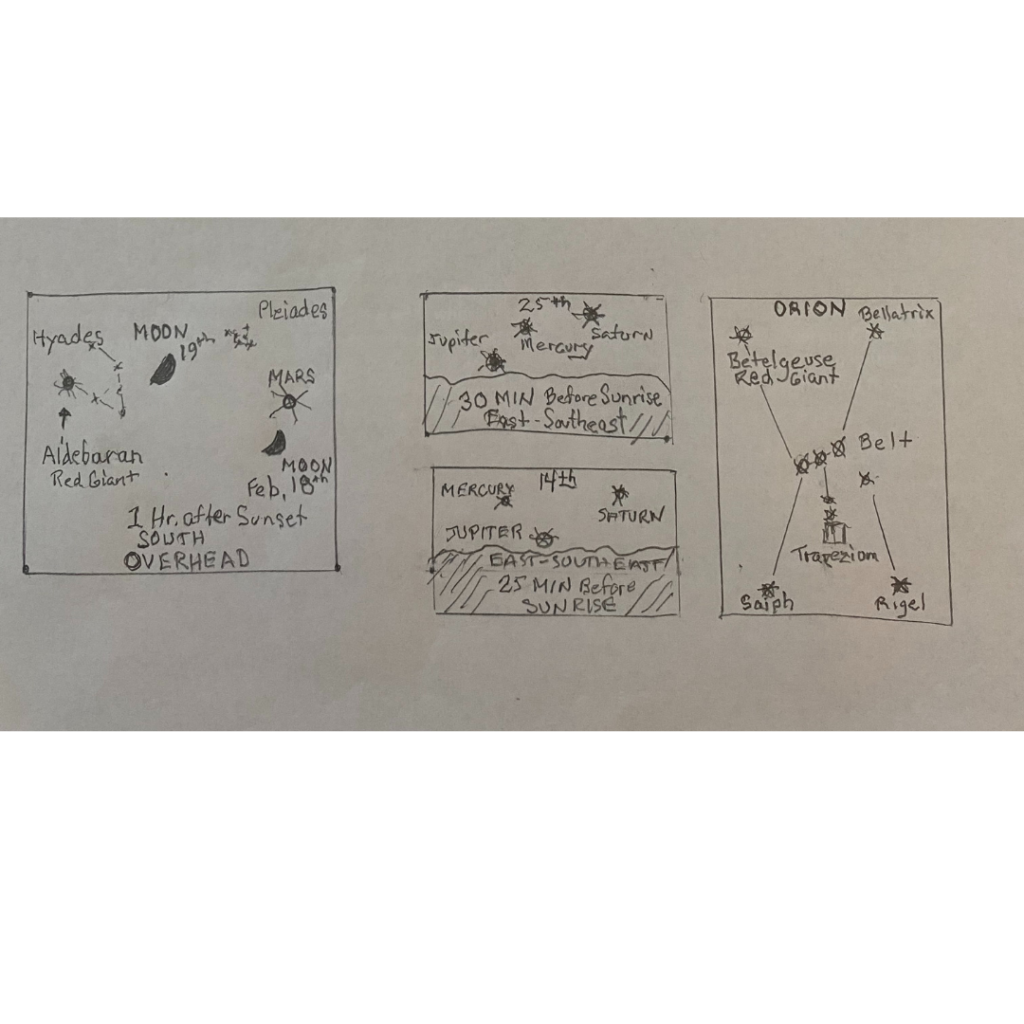February Viewing
The Celestial Sphere
By Matthew Johnson

The five planets visible to the naked eye, Mercury, Venus, Mars, Jupiter and Saturn, were present in our skies throughout the summer, fall and early winter of 2020, with Venus gracing the sky at dawn. The comet Neowise joined them briefly in July and August.
But in January 2021, the orbits of Mercury, Venus, Jupiter and Saturn passed behind the sun, only to reappear in February for a half hour or so in the early morning sky, just before sunrise. Venus is still hidden from view. This leaves Mars, glowing reddish-orange in the south-southwest, as the only naked-eye planet still in view.
Nighttime viewing:
Mars is best viewed on Feb. 18 and 19, just an hour or so after sunset. On the 18th, Mars can be found with the large crescent moon below it; on the 19th, it is to the right of the crescent moon, which itself is located exactly between the beautiful V-shaped Hyades cluster of stars and the glorious, brilliant blue Pleiades cluster. Both clusters are part of the zodiacal constellation of Taurus, the Bull. Notice the star Aldebaran, “the eye of Taurus,” in the Hyades cluster. It is one of only three red giant stars that we are able to see from Earth.
Early morning viewing:
The planets Mercury, Saturn and Jupiter can best be seen together when looking east-southeast 20 minutes before sunrise on the mornings of Feb. 14 and 30 minutes before sunrise on the 25th. The three planets form a triangle and are all very low on the horizon. These planets are at present located in the zodiacal constellation Capricorn, the Sea Goat. To see them, you will need a vantage point without hills or trees. On Feb. 14, Jupiter will just skirt the skyline, with Mercury to its left and Saturn to its right. On the 25th, the planets are juxtaposed, with both Mercury and Saturn appearing to the right and above Jupiter.
Constellations:
Winter’s most glorious constellation, Orion, the Hunter or Warrior, offers us more than just a beacon of the brightest stars in the heavens, including Betelgeuse, the second of our three red giant stars. In the area of Orion’s sword called the Trapezium is a region where stars and planets are born. Here there is a vast cloud of hydrogen gas, light years thick. To the naked eye, this area of star birth appears as a tiny patch of haze. Within this haze we can observe stars and solar systems being born. In the late 1990s the Hubble telescope confirmed the presence of proto-planetary discs around newly forming stars in the Trapezium.
To view the Trapezium, look up at Orion and find the three stars, Alnitak, Alnilam and Mintaka, which form Orion’s belt. Now, look down from Alnilam, the middle star, to the group of stars forming Orion’s “sword.” There, in a fuzzy zone of light in the lower part of the sword, stars and solar systems are forming!
Meteor showers:
There are no meteor showers in February, although there will always be an occasional meteor.
Phases of the moon:
Feb. 4: Last quarter (left half of the moon illuminated).
Feb. 11: New moon (no visible moon). The best time of the month to observe faint objects such as distant galaxies and star clusters is during the few days before and after the new moon, when there is no moonlight to interfere.
Feb. 19: First quarter (right half of the moon illuminated).
Feb. 27: Full moon. December’s full moon was known by Native American tribes as the Snow Moon. A few tribes named February’s full moon the Hunger Moon owing to the scarce food sources and difficult hunting conditions during midwinter, while others named it the Storm Moon.
Matthew Johnson will be participating in this winter’s Weekend in Norfolk, which starts on Feb. 20. His video on Norfolk’s dark skies, some of the darkest in Connecticut, will be available on the WIN website.
